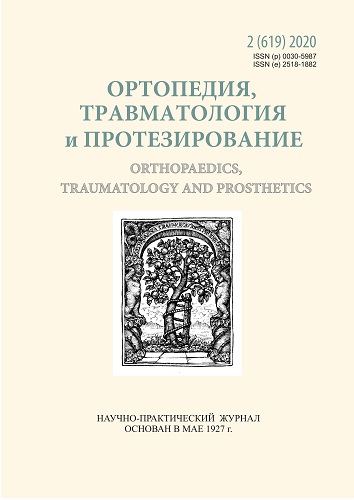Features and results of treatment of rotationally unstable pelvic injuries of the «open book» type
DOI:
https://doi.org/10.15674/0030-59872020216-23Keywords:
pelvic fracture of the «open book» type, anterior part of the pelvic bones, posterior part of the pelvic bones, pubic joints, osteosynthesisAbstract
The treatment of pelvic bones injuries is one of the most difficult problems in traumatology. Objective: to analyze the results of surgical treatment of patients with pelvic fractures of the «open book» type and to determine the most effective methods of its stabilization. Methods: a retrospective analysis of the results of treatment of 61 patients with «open book» type pelvic fractures (age from 16 to 64 years) in two groups was carried out. Patients of the first group (24 patients, 39.3 %) were made osteosynthesis the anterior part of the pelvic bones only with an external fixation device — 20 and with a plate — 4. In the second group (37 patients, 60.7 %), anterior and posterior osteosynthesis was made. To assess fractures, the Tile classification with the additions of AO was used. X-rays and CT of the pelvic bones was used in all cases. Fractures of type B1.1 were detected in 32 (52.5 %) cases, B1.2 — 29 (47.5 %). Surgery was planned according to the developed local protocol. The results were analyzed according to the system of functional assessment S. A. Majed. The follow-up period was from 6 to 12 months after the surgery. Results: early complications were found in 4 (6.5 %) patients: infection — 3, secondary displacement of bone fragments — 1. There was no significant difference between the groups in terms of treatment outcomes. Conclusions: in case of pelvic injury as an «open book», accurate diagnosis of injuries with assessment of sacroiliac connection using x-ray of the pelvis in three planes and CT are important. In case of injuries of type B1 and differences in the pubic joint up to 2.5 cm, conservative treatment is recommended, more than 2.5 cm — internal fixation of the anterior section by one or two plates, and in the case of suspected injury of sacroiliac joint, additional fixation of the sacroiliac joint with ileosacral screws.References
- Ankin, M. L., & Burluka, V. V. (2019). Pelvic injuries and hip fractures. Unified clinical protocol (primary, secondary (specialized), third (highly specialized) medical care. Kyiv. [in Ukrainian]
- Guthrie, H. C., Owens, R. W., & Bircher, M. D. (2010). Fractures of the pelvis. The Journal of Bone and Joint Surgery. British volume, 92(11), 1481-1488. doi: 10.1302/0301-620x.92b11.25911
- Tile, M., Helfet, D. L., Kellam, J. F., & Vrahas, M. (2015). Fractures of the Pelvis and Acetabulum Principles and Methods of Management (4th ed.). Davos: AO Publishing
- Marsh, J. L., Slongo, T. F., Agel, J., Broderick, J. S., Creevey, W., DeCoster, T. A., … & Audigé, L. (2007). Fracture and dislocation classification compendium - 2007. Journal of Orthopaedic Trauma, 21(Supplement), S1-S6. doi: 10.1097/00005131-200711101-00001
- (1996). Fracture and dislocation compendium. Orthopaedic trauma association committee for coding and classification. Journal of Orthopaedic Trauma, 10(1), 1–154.
- Majeed, S. (1989). Grading the outcome of pelvic fractures. The Journal of Bone and Joint Surgery. British volume, 71(2), 304-306. doi: 10.1302/0301-620x.71b2.2925751
- Tile, M., Helfet, D., & Kellam. J. (2003). Biomechanics of the pelvic ring. Fractures of the pelvis and acetabulum. Philadelphia: Lippincott Williams & Wilkins
- Tornetta, P., Dickson, K., & Matta, J. M. (1996). Outcome of rotationally unstable pelvic ring injuries treated operatively. Clinical Orthopaedics & Related Research, 329, 147-151. doi: 10.1097/00003086-199608000-00018
- Matta, J. M. (1996). Indications for anterior fixation of pelvic fractures. Clinical Orthopaedics & Related Research, 329, 88-96. doi: 10.1097/00003086-199608000-00011
Downloads
How to Cite
Issue
Section
License
Copyright (c) 2020 Mykola Ankin, Taras Petryk, Viktoriia Ladyka

This work is licensed under a Creative Commons Attribution 4.0 International License.
The authors retain the right of authorship of their manuscript and pass the journal the right of the first publication of this article, which automatically become available from the date of publication under the terms of Creative Commons Attribution License, which allows others to freely distribute the published manuscript with mandatory linking to authors of the original research and the first publication of this one in this journal.
Authors have the right to enter into a separate supplemental agreement on the additional non-exclusive distribution of manuscript in the form in which it was published by the journal (i.e. to put work in electronic storage of an institution or publish as a part of the book) while maintaining the reference to the first publication of the manuscript in this journal.
The editorial policy of the journal allows authors and encourages manuscript accommodation online (i.e. in storage of an institution or on the personal websites) as before submission of the manuscript to the editorial office, and during its editorial processing because it contributes to productive scientific discussion and positively affects the efficiency and dynamics of the published manuscript citation (see The Effect of Open Access).














